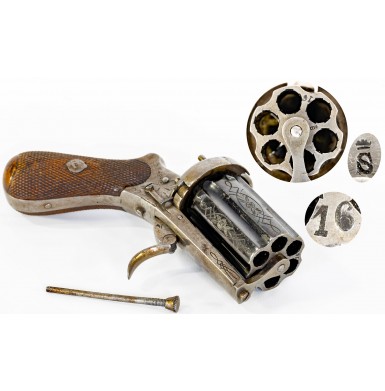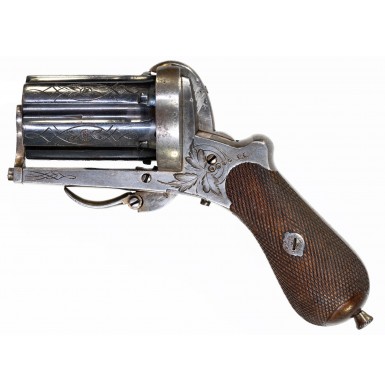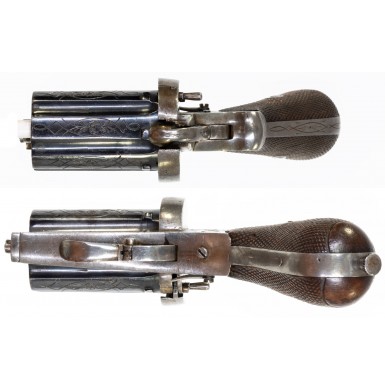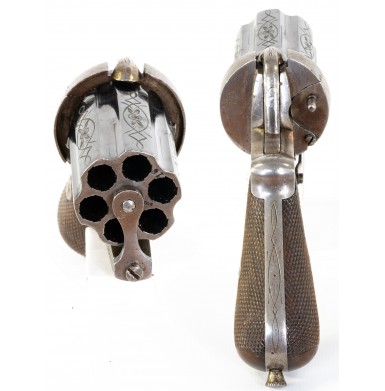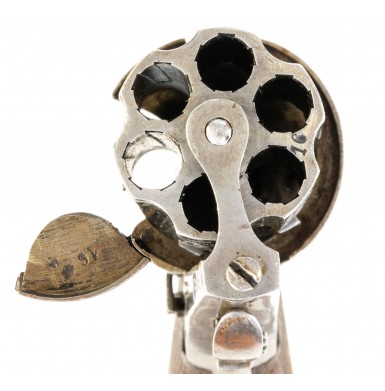Fine Continental "Casse Tête" aka “Apache” 9mm Dual Ignition Pocket Pistol
- Product Code: FHG-3516
- Availability: Out Of Stock
-
$1,895.00
In the mid-19th century, the introduction of self-contained metallic cartridge ammunition allowed the concept of the extremely small, multiple shot, easily concealed self-protection handgun to be revisited and taken to new levels. In America, the most famous example was the classic Remington Model 95 “Elliot’s Patent” over and under derringer pistol. This design is well-known due to Hollywood’s use of these guns in hundreds of westerns as the preferred “hide out” gun of gamblers, ladies of the evening and heroes like James West in the television show Wild, Wild West. In Europe, the preferred variant of these deep concealment handguns was a folding trigger double action revolver rather than a two-shot over and under handgun and received the nickname “Apache”.
The concept and design of the “Apache” is credited to Belgian gun designer Louis Dolne of Liège. Stockel lists Dolne as working circa 1873-1881 and as the creator of the “Casse Tête” (Brain Teaser) revolver which later received the nickname “Apache” due to the use of these revolvers by late 19th and early 20th century French criminals known colloquially as Les Apaches. As originally designed, Dolne’s concept combined a set of folding brass or iron knuckles with a revolving double action only miniature pepperbox style revolver that did not have a barrel. This allowed the knuckle fixture to serve as the revolver’s grip and also provided a built-in way to utilize the gun as an impact weapon in hand-to-hand fighting. Later versions of the guns were produced with folding knife blades and similar devices, turning the guns into a sort of “Swiss Army Knife” with multiple appendages and harkening back to the days of the James Rogers and Unwin & Rogers “Self-Protector” knife pistols of the percussion era.
The revolver portion of the gun typically included a five or six chambered cylinder that was loaded via a loading gate in the right rear of the frame and required a small rod that was often threaded into the grip for storage, to eject the spent rounds. The guns were primarily chambered for pinfire ammunition and usually in 7mm. The action was double action only and typically utilized a folding trigger to make the gun more concealable and less likely to snag when being drawn from a pocket when needed. To increase the concealability of the guns and again to reduce the possibility of being snagged when drawn, the hammers were almost universally spurless. The popularity of the concept resulted in guns being produced as firearms only without the attendant knuckles or blades and while not technically “Casse Tête” revolvers, these were still often given the nickname “Apaches.” As the popularity of the design grew, a new version appeared that included a removable barrel. While the standard versions typically used rifled chambers in the pepperbox cylinder, these new variants allowed a barrel to be screwed into the frame of the revolver, turning the discrete carry gun into a more viable revolver that was capable of being used beyond contact distances with some level of accuracy.
Offered here is one of the more interesting variants of the “Casse Tête” or “Apache” revolver. This variant is larger bore than most of the guns that were produced and is chambered for the 9mm cartridge rather than the 7mm. It is also a dual ignition revolver that is designed to accept the standard pinfire cartridge that most of these guns utilize, as well as a centerfire 9mm cartridge. An additional firing pin is attached to the inner neck of the hammer which is positioned to strike a centerfire primer. It is worth noting that is has been reported that a 9mm Luger (9x19) variant of these guns was produced during World War II for the use of British Commandos, although I am not aware of any extant examples.
The revolver remains in FINE condition and retains much of the original blued finish on the 2 1/8” long barrel cluster. The six-barrel cluster is fluted and lightly engraved with intertwining lines. The frame is finished in the bright and engraved with simple foliate motifs. The gun includes the typical folding trigger to operate the double action only mechanism and loading gate at the left rear of the frame. An ejector rod is threaded into base of the grip frame. Unlike a traditional “Apache” this example does not incorporate any additional weapons into the design. Instead, it uses a conventional bag shaped grip with two-piece checkered walnut grips. The gun is unmarked other than the assembly number 16 on the face of the barrel cluster and on the inside face of the loading gate. Further disassembly would likely reveal additional assembly numbers. The only other marking is a {Crown/S} on the face of the barrel, which likely is a maker’s mark for the gun’s manufacturer. As no Liège proof mark is present on the gun, it is likely a French-made example. The revolver measures a compact and concealable 5 ¼” in overall length and is only 4 ¼” tall, including the projecting tip of the ejector rod in the butt.
As noted, the gun remains in FINE condition with most of the blue remaining on the barrel cluster. The blue does show some thinning and fading from age and pocket carry but remains extremely crisp. The engraving and markings remain clear and crisp as well. The design of the mechanism allows for the cylinder to rotate for loading and unloading without necessitating any additional manipulation of the action, placing the hammer on half cock or anything else. This simplifies the double action mechanism as traditionally a double action only system does not incorporate a half cock notch. The action design is similar to those produced under Joseph Chaineaux’s patent. The action of the revolver operates correctly and the revolver times, indexes and locks up as it should when the trigger is pulled. The loading gate operates correctly as well. The ejector rod securely threads into the butt of the gun and is easily removable to eject the spent cartridges. The two-piece walnut grips are in FINE condition as well. The wood is solid, complete, and free of any breaks, cracks, or repairs. The checkering remains crisp as well, with the grips showing only some light wear and minor handling marks and light dings.
Overall, this is a really high condition and attractive example of a nice piece of firearms curiosa. While these “Apache” style handguns appear on the market from time to time, they rarely appear in the larger 9mm caliber and almost never as a dual ignition gun capable of firing both pinfire and centerfire cartridges. These are a neat piece to display with any collection of mid-to-late 19th century European cartridge firearms or would be a fine addition a collection of pepperboxes, derringers, and other concealment handguns.
SOLD
Tags: Fine, Continental, Casse Tête, aka, Apache, 9mm, Dual, Ignition, Pocket, Pistol

